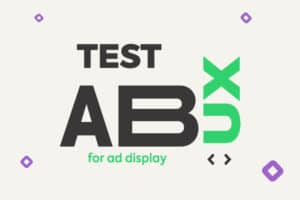The First Contentful Paint (FCP) is fundamental for measuring web performance. It indicates the time it takes for the largest element above the fold to be rendered and visible to the user. For medium and large publishers, optimizing the FCP is essential to provide a good user experience, directly impacting the perception of site speed. Grumft, a specialist in site and app monetization, is here to help you understand and improve your site’s FCP.
Index
Understanding the First Contentful Paint
What is the FCP?
The FCP is the time it takes for the browser to render and display the largest element above the fold of the page. It can be an image, a block of text, or any other HTML element. It is the first visual impression of your site for the user.
Why is the First Contentful Paint important?
A fast FCP is essential for:
- Improving user experience: Pages with a fast FCP are perceived as faster and more responsive, increasing user satisfaction and reducing bounce rates.
- Increasing SEO: Google considers the FCP a ranking factor. Therefore, optimizing it can improve your site’s position in search results.
- Reducing bounce rates: Users tend to abandon sites that load slowly, which can lead to lost conversions and sales.
Measuring the First Contentful Paint
Measurement tools
There are various tools to measure your site’s FCP, such as:
- PageSpeed Insights: https://pagespeed.web.dev/
- Chrome DevTools: https://www.chromium.org/devtools/
- WebPageTest: https://www.webpagetest.org/
- GTmetrix: https://gtmetrix.com/
Interpreting the results
- Good: FCP below 1.8 seconds
- Needs Improvement: FCP between 1.8 and 3 seconds
- Poor: FCP above 3 seconds
Optimizing the FCP
Image optimization
- Image compression: Reduce the size of image files without compromising visual quality.
- Use modern image formats: Utilize formats like WebP and Avif, which offer better compression.
- Preload above-the-fold images: Load critical images in advance so they display more quickly.
Minification of HTML, CSS, and JavaScript
- Remove unnecessary whitespace, comments, and redundant code: Use minification tools to automatically optimize your files.
Deferring JavaScript loading
- Defer loading of non-essential scripts: Use attributes like async and defer to manage JavaScript loading without blocking the main content rendering.
Font optimization
- Use optimized web fonts: Size them appropriately for the screen and host fonts locally or use a font CDN.
Reducing DOM size
- Minimize the number of HTML elements on your page: Avoid excessive use of nested divs to reduce rendering time.
Eliminating redirects
- Avoid unnecessary redirects: Use 301 (permanent) redirects instead of 302 (temporary).
Using a CDN
- Content Delivery Network (CDN): Distribute your content to servers worldwide, reducing latency and load times for users in different locations.
Server optimization
- Choose an adequate web server: Ensure it has enough resources to handle your site’s traffic.
- Use caching tools: Store static content to reduce server response times.
Monitoring and follow-up
Regularly monitor the First Contentful Paint
- Monitoring tools: Use them to track your site’s FCP over time and identify bottlenecks.
Continue optimizing
- Ongoing process: Keep looking for new ways to improve your site’s performance, staying updated with best practices.
Useful tools for optimizing the First Contentful Paint
- PageSpeed Insights: https://pagespeed.web.dev/
- Chrome DevTools: https://www.chromium.org/devtools/
- WebPageTest: https://www.webpagetest.org/
- GTmetrix: https://gtmetrix.com/
Additional considerations
Mobile optimization
It’s crucial to optimize the FCP for mobile devices, as users tend to be more sensitive to load times on their smartphones.
A/B testing
Use A/B testing to compare different versions of your site and identify those that result in better FCP.
Stay updated
Follow the latest recommended practices for FCP optimization and keep your site updated with the best techniques.
Conclusion
A fast FCP is essential for your site’s success. By optimizing the FCP, you improve your visitors’ experience, increase conversion chances, and boost your business. For additional resources and official information on the subject, use the provided tools and links. And rely on Grumft, a specialist in site and app monetization, which develops tags that do not affect the user experience. Contact us to leverage our expertise and maximize your site’s performance and monetization, and have the confidence of partnering with a Google MCM.





